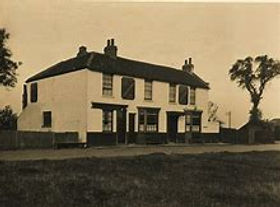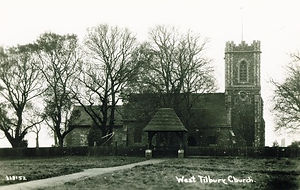West Tilbury Village Hall
From the records
653 A.D. – The first written reference to “Tillaburg” in the Anglo-Saxon Chronicle. Bishop Cedd founds a monastery near the Thames edge.
1066 – The manor belongs to Aelfric the Saxon, a priest. There are 60 sheep.
1086 – Swein of Essex owns the manor, his tenants in chief are two Frenchmen, Osbern and Ralf. There are 260 sheep, 31 cattle, 12 goats and 9 pigs.
c. 1200 – The church is founded on its present site at “LittleTiliburi”
1257 – Richard de Tilbury is granted a Wednesday market at West Tilbury by the King. He lays out the present green as a village square.
1323 – Cranes Farm, referred to in a grant as “Snarrieslond”, comes in to the possession of a lady called Grecia Senaries.
1327 – Fourteen named West Tilbury persons are taxed to raise money for French wars.
1441 – Nicholas Condorowe holds the manor of Condovers at Low Street.
c. 1450 to 1480 – Marshall’s, Condovers, West Tilbury Hall and Well House farm houses built.
1540 – Henry VIII orders building of blockhouse fort and new marsh roads (Fort Road and Cooper Shaw Road) that cut across the green and other common land.
1584 – John Walker maps the manor house grounds and fields. This survey shows the fields and woodlands as well as the spring-fed stew pond next to Well House. He also mentions the "Fayre Green" where the weekly market is held.
1588 – Queen Elizabeth visits the Armada Camp at Gun Hill. Soldiers break stools and damage walls in St.James’s Church.
1609 to 1616 – William Laud holds Rectory of the parish. He later becomes Archbishop of Canterbury. Executed by orders of Parliament in 1645.
1652 – Susan Haveringe accused of witchcraft; alleged she bewitched to death 3 bay colts of Robert Smith.
c. 1660 – Sir Richard Hatton builds Bluehouse (Manor Farm) by the Green.
1676 – William Nevison, a highwayman (the “Real” Dick Turpin) rides through West Tilbury on his gallop to York.
1695 – Village gets postal service, delivered 3 days per week from the “George” at Grays.
1712 – St. James’s church collapses. Rebuilt c. 1713 by Rev. William Philps.
1718 – Sir John Cass makes will, leaving Hoford Farm rents to pay for schooling and clothing of poor children at Aldgate (now the Cass Foundation)
1724 – John Kellaway, lord of the manor, sinks a well which soon becomes famous as a medicinal water spring.
1736 – Great Tide. Marshes flooded as far inland as Low Street.
1752 – West Tilbury fair on the Green declared an "event of lewdness and debauchery". The East India ship “Tilbury” sails for Bombay – named after the village and owned by Thomas Hunt of West Tilbury Hall.
1793 – Turnpike Act establishes the first toll gates on Fort Road Common and Muckingford Road.
1798 – Rev. Sir Adam Gordon Bart. Buys the “Old King's Head” pub and turns it in to a rectory house.
1801 – First census. Population 201.
1811 – Samuel Turner appeals for a penny post delivery to the village. Postmaster General approves. Population 117.
1837 – The Low Street workhouse closes and paupers are removed to Orsett.
1848 The “King’s Head” operates as first village post office under Edward Travis, wheelwright.
1849 – Seabrooke’s brewery buys the “Blue Anchor” beershop.
1854 – Low Street station opens on the Eastern Counties Railway. Single line only. Population 259.
1872 – James Burness acquires the West Tilbury estate. Population 372.
1876 – West Tilbury school opens. Enlarged 1894.
1879 to 1880 – St. James’s Church rebuilt and dedicated April 1880.
1883 – Tower added to church.
1891 – Over 100 gipsies encamped on West Tilbury commons. Population 439.
1895 – All commons registered and regulated by Act of Parliament.
1905 – Smock mill demolished at Mill House. Joseph James last miller in village.
1914 to 1918 – Nine parishoners killed on active service.
1924 – Memorial hall opened. Population 418. George Burness gave permission for the hall to be built on a plot of land owned by him. Funds to build the hall were raised by many local residents and the efforts of Captain E.A. Loftus and the Reverend J.R.Fellowes.
1931 – Most of the Burness estate sold to Allen Charles Cole. During this year, the land upon which the hall stands was given to the Trustees of the village hall and institute by George Burness.
1939 – The smith’s forge demolished.
1939 to 1946 – Four parishoners killed on active service.
1953 – Great tide and storm. Extensive flooding caused loss of life and destruction of property. Gun Hill used as a searchlight base for illuminating work on breaches at Marsh Farm.
1960 – School closes. Last Headmistress Miss Grover.
1969 – Low Street Station closes. An early Saxon settlement is discovered on Gun Hill.
1977 – West Tilbury becomes part of a new ecclesiastical parish with East Tilbury and Linford.
1985 – Historical photographs of West Tilbury village and its rectors hung on permanent display in Memorial Hall. Roman potters kiln found.
With acknowledgements to Thurrock Museums Service.

< A view of the village looking North. Taken before the turn of the 20th Century from the church tower.
The King's Head public house (now closed down) taken in the 1930s >


< Every year in May the Rogation Sunday service is held in West Tilbury. Rogation Sunday is the day when the Church has traditionally offered prayer for God’s blessings on the fruits of the earth and the labours of those who produce our food.
St. James' Church, taken at the turn of the twentieth century >
